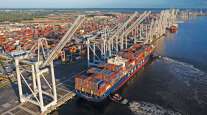Senior Reporter
GAO: Condition of Large U.S. Bridges Improving, but Challenges Remain

The condition of the nation’s large bridges has improved over the last decade, but state transportation officials have faced challenges constructing or completing major projects on large bridges over the past five years, according to a new report by a congressional watchdog agency.
“Despite overall improvement in bridge conditions, some transportation stakeholders continue to point out the length of time it takes to complete major transportation projects, including those on some of the nation’s largest bridges,” a new Government Accountability Office report said.
SPAN STUDY: Congressional watchdog assesses the nation's bridges
Much of the information contained in the report was optimistic, despite the fact that billions of dollars are needed to repair and construct some of the nation’s more than 6,100 structures classified as “large bridges” — major bridge projects that represent less than 1% of all bridges.
“Overall, what we’re saying is that major bridges — and all bridges — seem to be in a little better shape, or improving, in terms of their condition,” Mark Goldstein, director of physical infrastructure issue for GAO, told Transport Topics. “Larger bridges are often older, and they are often more complex to repair or replace because of their size, age or funding requirements. There is funding available, but there are so many challenges and hurdles to getting them done in a timely manner.”

The GAO’s 53-page report on the condition of bridges costing more than $500 million to build or rehabilitate was based on an analysis of 2007-2016 data from the Federal Highway Administration’s National Bridge Inventory. It was presented to congressional transportation leaders late last month.
“The percentage of deck area that FHWA identified as structurally deficient on the nation’s large bridges decreased from 11.2% to 7.5% and the percentage of large bridges that were structurally deficient also declined, from 10.2% to 6.4%,” GAO said.
However, large bridges, on average 34 years old, are in slightly worse condition than other bridges — nearly 43 years old on average, GAO said.
“For example, the report said that in 2016, 7.5% of the deck area of all large bridges was structurally deficient compared to 6.1% of the deck area of all bridges.
Specifically, the GAO found that the percentage of deck area that was structurally deficient on large bridges ranged from 0% to 27% among states.
“There could be a number of explanations for this variation in the condition of states’ large bridges, including the age of the bridge inventory, climate, states’ funding priorities, and the total number of large bridges in the state,” the report said.
There was no structurally deficient deck area on large bridges in Hawaii, Maine, Nevada, North Dakota, Utah, Vermont and Wyoming. However, 27% of deck area on large bridges in Connecticut and Massachusetts was structurally deficient, according to GAO.
Obtaining the funding to fix and build large bridges has become more problematic in recent years due largely to the fact that the buying power of motor fuel and other truck-related taxes that provide the major source of federal surface transportation funding is “eroding.”
The report also found that state transportation officials face challenges fixing and building large bridges that most commonly include public opposition, right-of-way acquisition and obtaining environmental permits.
GAO said that communities may be opposed to one or more components of a major bridge project, such as tolls, noise or the bridge’s design.
Right-of-way acquisition can require the owners of large bridges to acquire nearby land and relocate property, which could include railroads, utilities or private homes. Also, it can take years for federal and state agencies to assess the effects of a project on the environment and issue permits to allow construction.




